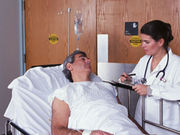Readmission rates below 1 percent for those hospitalized and those discharged, not hospitalized
THURSDAY, Nov. 2, 2017 (HealthDay News) — Most patients presenting to the emergency department (ED) with a primary diagnosis of syncope are discharged and have a favorable prognosis, and though total costs to care for discharged syncope patients are high, cost per patient is lower compared with hospitalized patients, according to a study published online Nov. 1 in JACC: Clinical Electrophysiology.
Roopinder K. Sandhu, M.D., M.P.H., from the University of Alberta in Canada, and colleagues examined outcomes and costs for 51,831 consecutive patients presenting to the ED with a primary diagnosis of syncope from 2006 to 2014.
The researchers found that 6.6 percent of patients were hospitalized and discharged with a primary diagnosis of syncope (cohort 1), 8.7 percent were hospitalized and discharged with a primary diagnosis other than syncope (cohort 2), and 84.7 percent were discharged home from the ED with a diagnosis of syncope (cohort 3). There was variation in 30-day ED revisits for syncope from 1.2 to 2.4 percent for cohorts 2 and 1, respectively; readmission rates were below 1 percent among the cohorts. Short- and long-term mortality rates were highest and lowest for cohorts 2 and 3, respectively (30-day mortality: 1.2, 5.2, and 0.4 percent for cohorts 1, 2, and 3, respectively; one-year mortality: 9.2, 17.7, and 3 percent, respectively). The total cost of syncope presentation was $534.8 million ($76.7 million, $139.4 million, and $318.7 million for cohorts 1, 2, and 3, respectively).
“Further research is needed for cost-saving strategies across all cohorts,” the authors write.
Copyright © 2017 HealthDay. All rights reserved.








